Organizational Behaviour Report: Sainsbury's Culture and Performance
VerifiedAdded on 2023/01/17
|12
|4078
|93
Report
AI Summary
This report provides an in-depth analysis of organizational behaviour, specifically within the context of Sainsbury's. It explores the influence of culture, politics, and power on individual and team performance, highlighting Sainsbury's role culture and its impact. The report delves into motivation, examining various theories such as Maslow's hierarchy of needs, ERG theory, and process theories like Vroom's expectancy theory, along with practical motivation techniques. Furthermore, it differentiates between effective and ineffective teams by analyzing characteristics such as objectives, open discussion, and decision-making processes. The report also touches upon the philosophies and concepts of organizational behaviour, offering a comprehensive understanding of the subject matter within the framework of Sainsbury's operations.
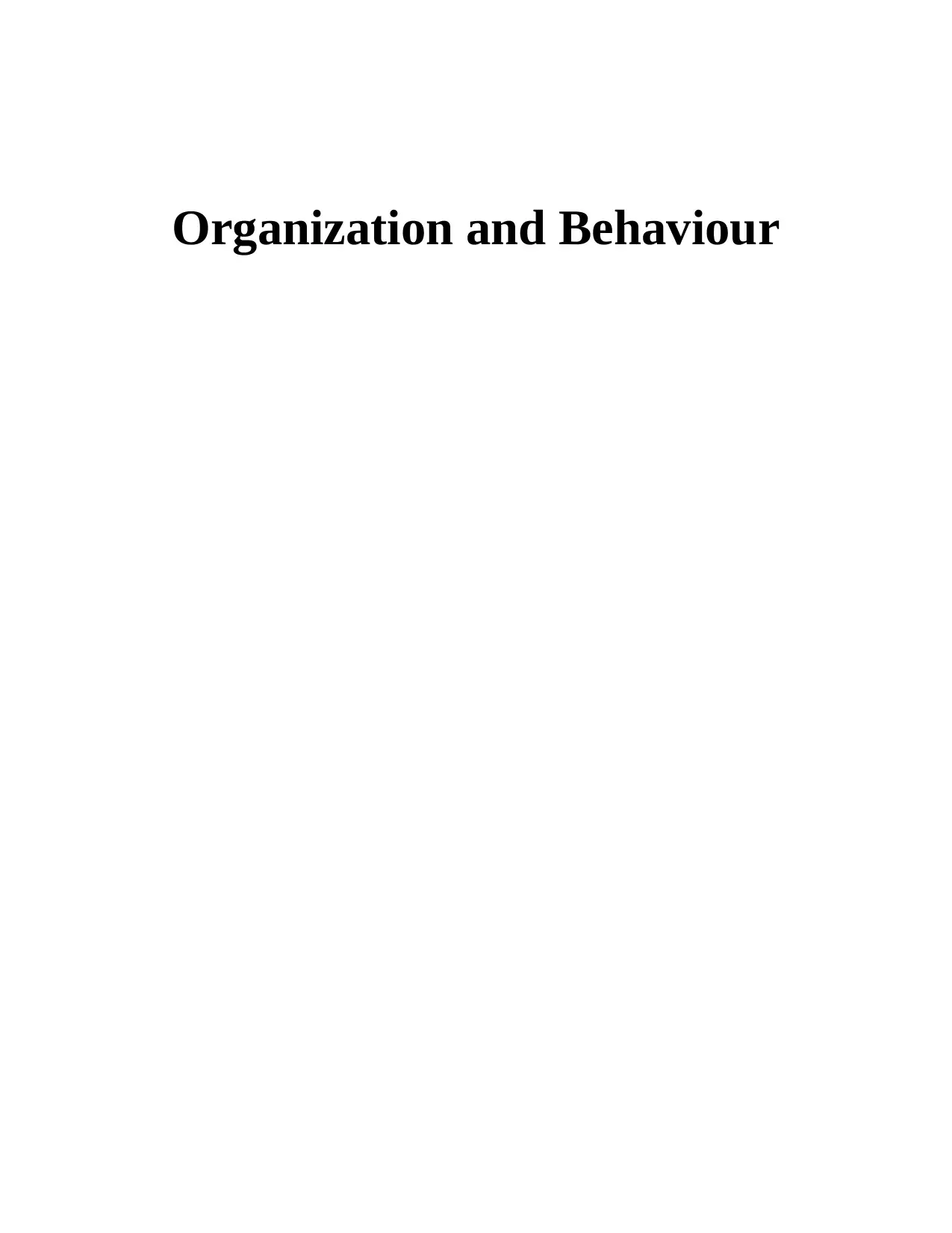
Organization and Behaviour
Paraphrase This Document
Need a fresh take? Get an instant paraphrase of this document with our AI Paraphraser
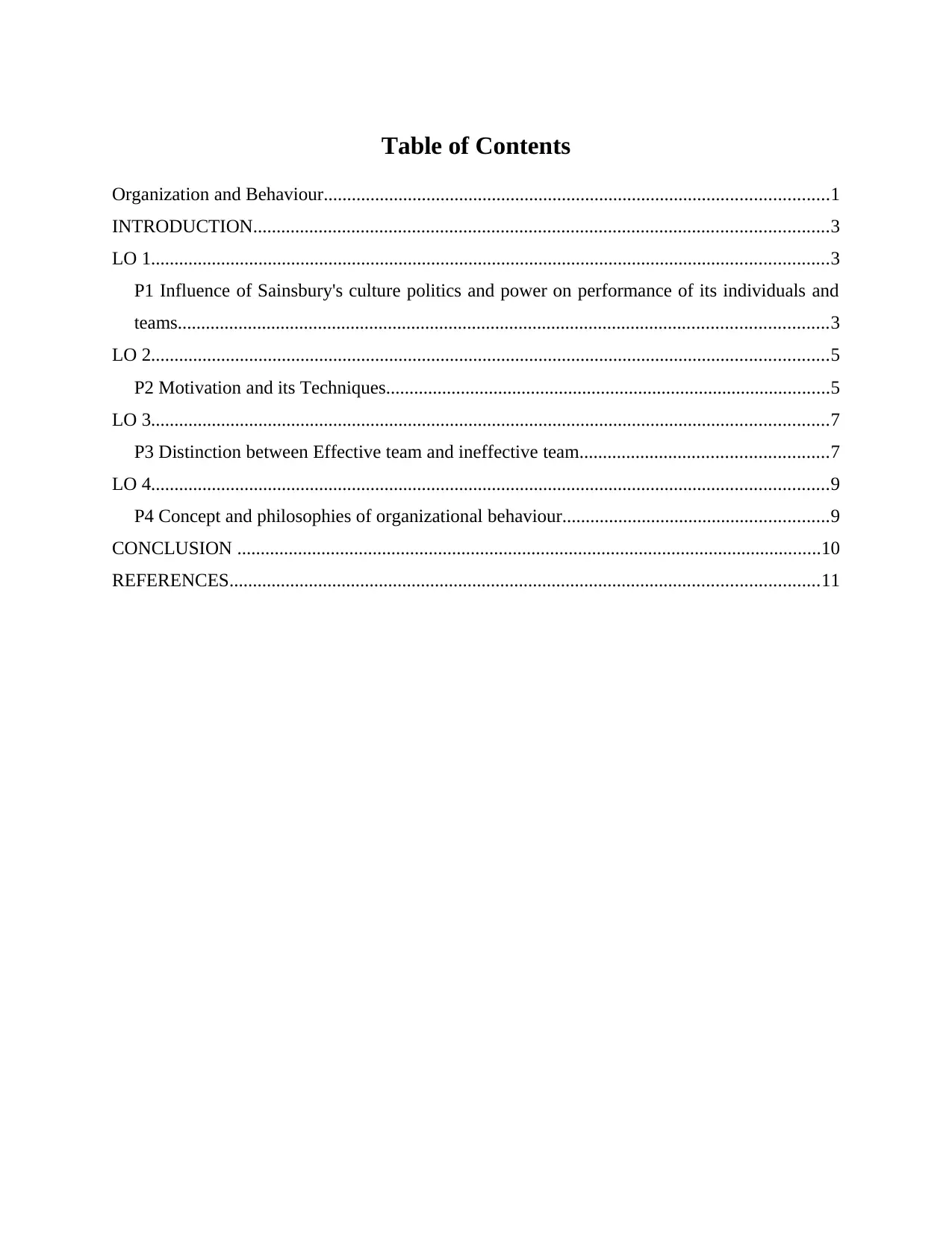
Table of Contents
Organization and Behaviour............................................................................................................1
INTRODUCTION...........................................................................................................................3
LO 1.................................................................................................................................................3
P1 Influence of Sainsbury's culture politics and power on performance of its individuals and
teams...........................................................................................................................................3
LO 2.................................................................................................................................................5
P2 Motivation and its Techniques...............................................................................................5
LO 3.................................................................................................................................................7
P3 Distinction between Effective team and ineffective team.....................................................7
LO 4.................................................................................................................................................9
P4 Concept and philosophies of organizational behaviour.........................................................9
CONCLUSION .............................................................................................................................10
REFERENCES..............................................................................................................................11
Organization and Behaviour............................................................................................................1
INTRODUCTION...........................................................................................................................3
LO 1.................................................................................................................................................3
P1 Influence of Sainsbury's culture politics and power on performance of its individuals and
teams...........................................................................................................................................3
LO 2.................................................................................................................................................5
P2 Motivation and its Techniques...............................................................................................5
LO 3.................................................................................................................................................7
P3 Distinction between Effective team and ineffective team.....................................................7
LO 4.................................................................................................................................................9
P4 Concept and philosophies of organizational behaviour.........................................................9
CONCLUSION .............................................................................................................................10
REFERENCES..............................................................................................................................11
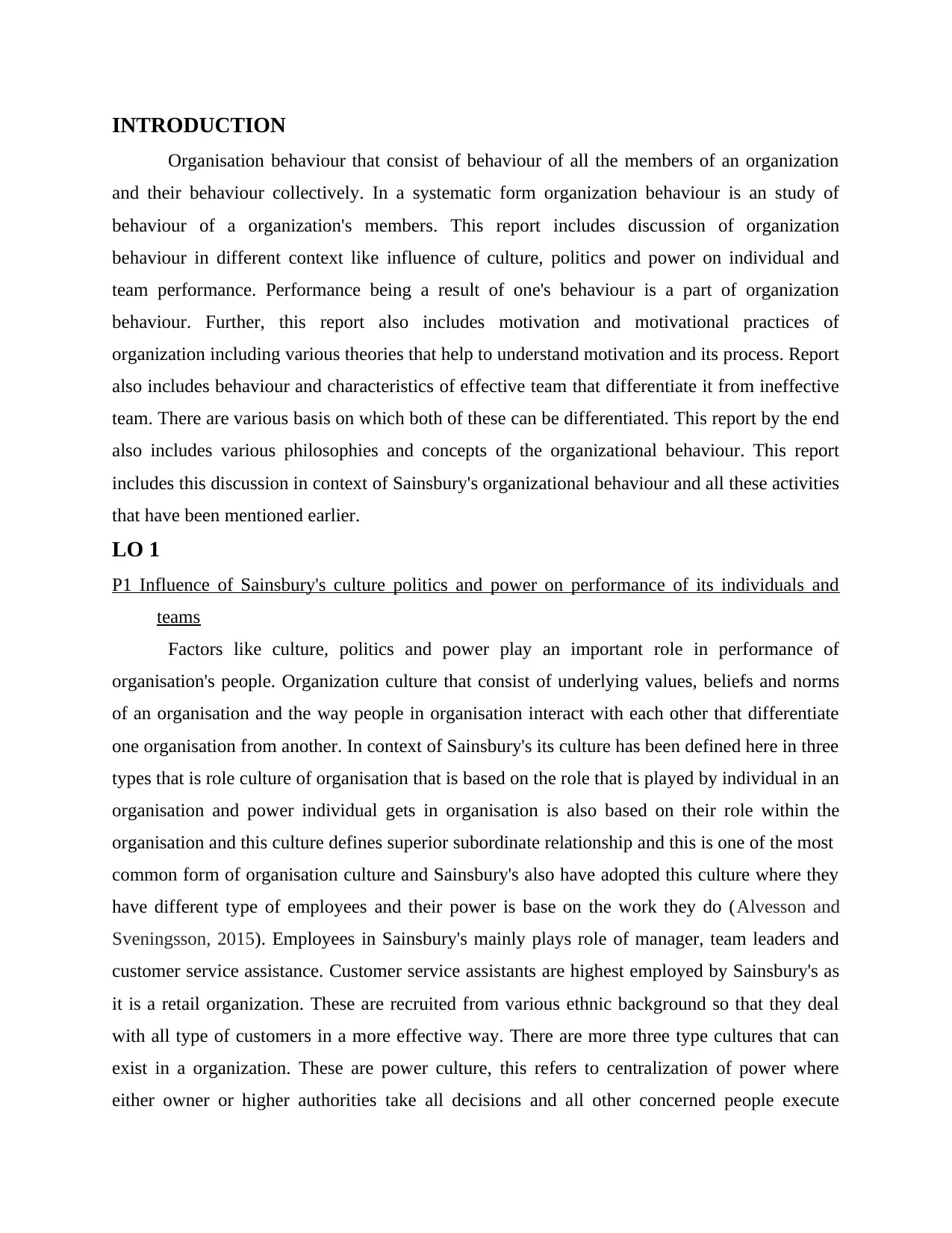
INTRODUCTION
Organisation behaviour that consist of behaviour of all the members of an organization
and their behaviour collectively. In a systematic form organization behaviour is an study of
behaviour of a organization's members. This report includes discussion of organization
behaviour in different context like influence of culture, politics and power on individual and
team performance. Performance being a result of one's behaviour is a part of organization
behaviour. Further, this report also includes motivation and motivational practices of
organization including various theories that help to understand motivation and its process. Report
also includes behaviour and characteristics of effective team that differentiate it from ineffective
team. There are various basis on which both of these can be differentiated. This report by the end
also includes various philosophies and concepts of the organizational behaviour. This report
includes this discussion in context of Sainsbury's organizational behaviour and all these activities
that have been mentioned earlier.
LO 1
P1 Influence of Sainsbury's culture politics and power on performance of its individuals and
teams
Factors like culture, politics and power play an important role in performance of
organisation's people. Organization culture that consist of underlying values, beliefs and norms
of an organisation and the way people in organisation interact with each other that differentiate
one organisation from another. In context of Sainsbury's its culture has been defined here in three
types that is role culture of organisation that is based on the role that is played by individual in an
organisation and power individual gets in organisation is also based on their role within the
organisation and this culture defines superior subordinate relationship and this is one of the most
common form of organisation culture and Sainsbury's also have adopted this culture where they
have different type of employees and their power is base on the work they do (Alvesson and
Sveningsson, 2015). Employees in Sainsbury's mainly plays role of manager, team leaders and
customer service assistance. Customer service assistants are highest employed by Sainsbury's as
it is a retail organization. These are recruited from various ethnic background so that they deal
with all type of customers in a more effective way. There are more three type cultures that can
exist in a organization. These are power culture, this refers to centralization of power where
either owner or higher authorities take all decisions and all other concerned people execute
Organisation behaviour that consist of behaviour of all the members of an organization
and their behaviour collectively. In a systematic form organization behaviour is an study of
behaviour of a organization's members. This report includes discussion of organization
behaviour in different context like influence of culture, politics and power on individual and
team performance. Performance being a result of one's behaviour is a part of organization
behaviour. Further, this report also includes motivation and motivational practices of
organization including various theories that help to understand motivation and its process. Report
also includes behaviour and characteristics of effective team that differentiate it from ineffective
team. There are various basis on which both of these can be differentiated. This report by the end
also includes various philosophies and concepts of the organizational behaviour. This report
includes this discussion in context of Sainsbury's organizational behaviour and all these activities
that have been mentioned earlier.
LO 1
P1 Influence of Sainsbury's culture politics and power on performance of its individuals and
teams
Factors like culture, politics and power play an important role in performance of
organisation's people. Organization culture that consist of underlying values, beliefs and norms
of an organisation and the way people in organisation interact with each other that differentiate
one organisation from another. In context of Sainsbury's its culture has been defined here in three
types that is role culture of organisation that is based on the role that is played by individual in an
organisation and power individual gets in organisation is also based on their role within the
organisation and this culture defines superior subordinate relationship and this is one of the most
common form of organisation culture and Sainsbury's also have adopted this culture where they
have different type of employees and their power is base on the work they do (Alvesson and
Sveningsson, 2015). Employees in Sainsbury's mainly plays role of manager, team leaders and
customer service assistance. Customer service assistants are highest employed by Sainsbury's as
it is a retail organization. These are recruited from various ethnic background so that they deal
with all type of customers in a more effective way. There are more three type cultures that can
exist in a organization. These are power culture, this refers to centralization of power where
either owner or higher authorities take all decisions and all other concerned people execute
⊘ This is a preview!⊘
Do you want full access?
Subscribe today to unlock all pages.

Trusted by 1+ million students worldwide
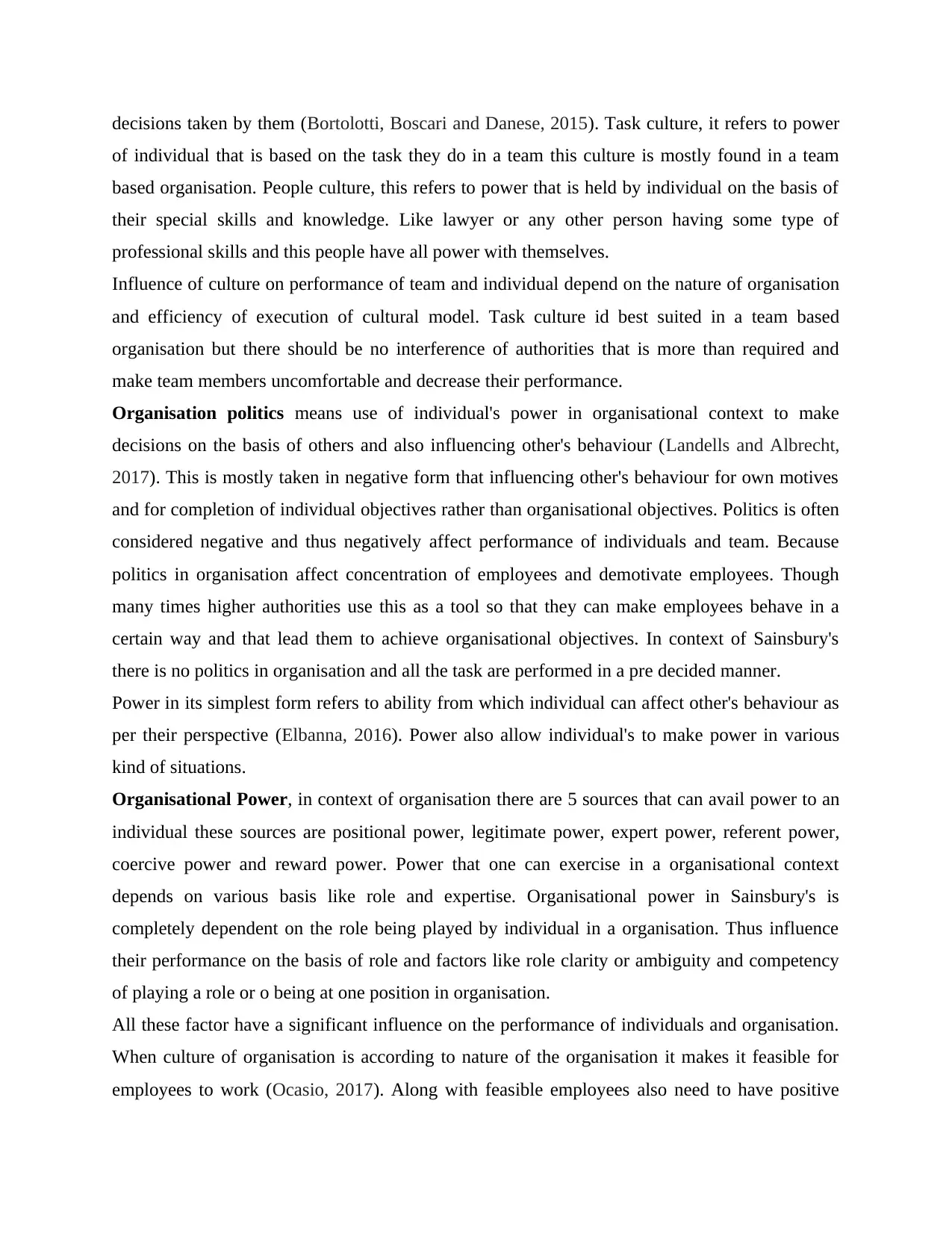
decisions taken by them (Bortolotti, Boscari and Danese, 2015). Task culture, it refers to power
of individual that is based on the task they do in a team this culture is mostly found in a team
based organisation. People culture, this refers to power that is held by individual on the basis of
their special skills and knowledge. Like lawyer or any other person having some type of
professional skills and this people have all power with themselves.
Influence of culture on performance of team and individual depend on the nature of organisation
and efficiency of execution of cultural model. Task culture id best suited in a team based
organisation but there should be no interference of authorities that is more than required and
make team members uncomfortable and decrease their performance.
Organisation politics means use of individual's power in organisational context to make
decisions on the basis of others and also influencing other's behaviour (Landells and Albrecht,
2017). This is mostly taken in negative form that influencing other's behaviour for own motives
and for completion of individual objectives rather than organisational objectives. Politics is often
considered negative and thus negatively affect performance of individuals and team. Because
politics in organisation affect concentration of employees and demotivate employees. Though
many times higher authorities use this as a tool so that they can make employees behave in a
certain way and that lead them to achieve organisational objectives. In context of Sainsbury's
there is no politics in organisation and all the task are performed in a pre decided manner.
Power in its simplest form refers to ability from which individual can affect other's behaviour as
per their perspective (Elbanna, 2016). Power also allow individual's to make power in various
kind of situations.
Organisational Power, in context of organisation there are 5 sources that can avail power to an
individual these sources are positional power, legitimate power, expert power, referent power,
coercive power and reward power. Power that one can exercise in a organisational context
depends on various basis like role and expertise. Organisational power in Sainsbury's is
completely dependent on the role being played by individual in a organisation. Thus influence
their performance on the basis of role and factors like role clarity or ambiguity and competency
of playing a role or o being at one position in organisation.
All these factor have a significant influence on the performance of individuals and organisation.
When culture of organisation is according to nature of the organisation it makes it feasible for
employees to work (Ocasio, 2017). Along with feasible employees also need to have positive
of individual that is based on the task they do in a team this culture is mostly found in a team
based organisation. People culture, this refers to power that is held by individual on the basis of
their special skills and knowledge. Like lawyer or any other person having some type of
professional skills and this people have all power with themselves.
Influence of culture on performance of team and individual depend on the nature of organisation
and efficiency of execution of cultural model. Task culture id best suited in a team based
organisation but there should be no interference of authorities that is more than required and
make team members uncomfortable and decrease their performance.
Organisation politics means use of individual's power in organisational context to make
decisions on the basis of others and also influencing other's behaviour (Landells and Albrecht,
2017). This is mostly taken in negative form that influencing other's behaviour for own motives
and for completion of individual objectives rather than organisational objectives. Politics is often
considered negative and thus negatively affect performance of individuals and team. Because
politics in organisation affect concentration of employees and demotivate employees. Though
many times higher authorities use this as a tool so that they can make employees behave in a
certain way and that lead them to achieve organisational objectives. In context of Sainsbury's
there is no politics in organisation and all the task are performed in a pre decided manner.
Power in its simplest form refers to ability from which individual can affect other's behaviour as
per their perspective (Elbanna, 2016). Power also allow individual's to make power in various
kind of situations.
Organisational Power, in context of organisation there are 5 sources that can avail power to an
individual these sources are positional power, legitimate power, expert power, referent power,
coercive power and reward power. Power that one can exercise in a organisational context
depends on various basis like role and expertise. Organisational power in Sainsbury's is
completely dependent on the role being played by individual in a organisation. Thus influence
their performance on the basis of role and factors like role clarity or ambiguity and competency
of playing a role or o being at one position in organisation.
All these factor have a significant influence on the performance of individuals and organisation.
When culture of organisation is according to nature of the organisation it makes it feasible for
employees to work (Ocasio, 2017). Along with feasible employees also need to have positive
Paraphrase This Document
Need a fresh take? Get an instant paraphrase of this document with our AI Paraphraser
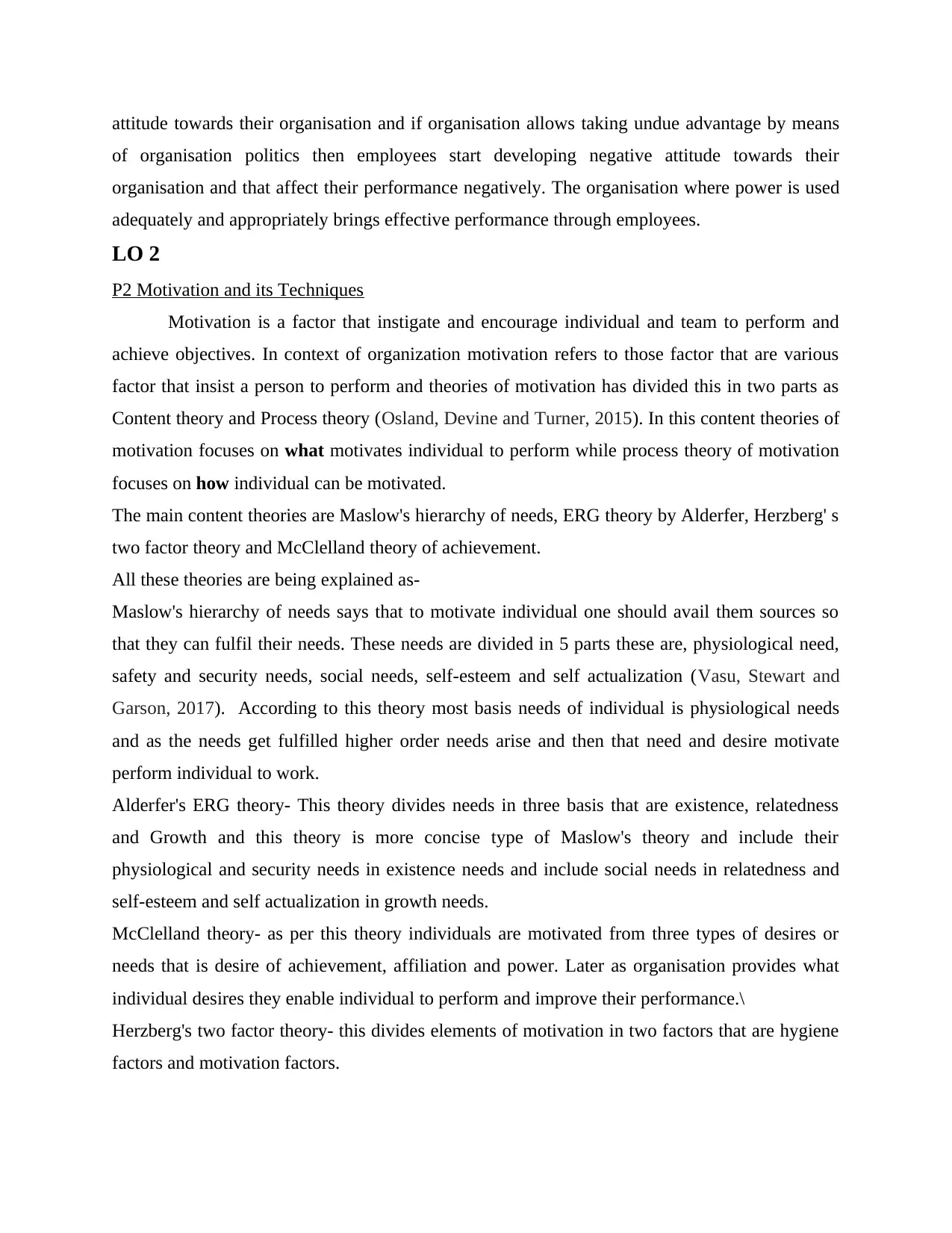
attitude towards their organisation and if organisation allows taking undue advantage by means
of organisation politics then employees start developing negative attitude towards their
organisation and that affect their performance negatively. The organisation where power is used
adequately and appropriately brings effective performance through employees.
LO 2
P2 Motivation and its Techniques
Motivation is a factor that instigate and encourage individual and team to perform and
achieve objectives. In context of organization motivation refers to those factor that are various
factor that insist a person to perform and theories of motivation has divided this in two parts as
Content theory and Process theory (Osland, Devine and Turner, 2015). In this content theories of
motivation focuses on what motivates individual to perform while process theory of motivation
focuses on how individual can be motivated.
The main content theories are Maslow's hierarchy of needs, ERG theory by Alderfer, Herzberg' s
two factor theory and McClelland theory of achievement.
All these theories are being explained as-
Maslow's hierarchy of needs says that to motivate individual one should avail them sources so
that they can fulfil their needs. These needs are divided in 5 parts these are, physiological need,
safety and security needs, social needs, self-esteem and self actualization (Vasu, Stewart and
Garson, 2017). According to this theory most basis needs of individual is physiological needs
and as the needs get fulfilled higher order needs arise and then that need and desire motivate
perform individual to work.
Alderfer's ERG theory- This theory divides needs in three basis that are existence, relatedness
and Growth and this theory is more concise type of Maslow's theory and include their
physiological and security needs in existence needs and include social needs in relatedness and
self-esteem and self actualization in growth needs.
McClelland theory- as per this theory individuals are motivated from three types of desires or
needs that is desire of achievement, affiliation and power. Later as organisation provides what
individual desires they enable individual to perform and improve their performance.\
Herzberg's two factor theory- this divides elements of motivation in two factors that are hygiene
factors and motivation factors.
of organisation politics then employees start developing negative attitude towards their
organisation and that affect their performance negatively. The organisation where power is used
adequately and appropriately brings effective performance through employees.
LO 2
P2 Motivation and its Techniques
Motivation is a factor that instigate and encourage individual and team to perform and
achieve objectives. In context of organization motivation refers to those factor that are various
factor that insist a person to perform and theories of motivation has divided this in two parts as
Content theory and Process theory (Osland, Devine and Turner, 2015). In this content theories of
motivation focuses on what motivates individual to perform while process theory of motivation
focuses on how individual can be motivated.
The main content theories are Maslow's hierarchy of needs, ERG theory by Alderfer, Herzberg' s
two factor theory and McClelland theory of achievement.
All these theories are being explained as-
Maslow's hierarchy of needs says that to motivate individual one should avail them sources so
that they can fulfil their needs. These needs are divided in 5 parts these are, physiological need,
safety and security needs, social needs, self-esteem and self actualization (Vasu, Stewart and
Garson, 2017). According to this theory most basis needs of individual is physiological needs
and as the needs get fulfilled higher order needs arise and then that need and desire motivate
perform individual to work.
Alderfer's ERG theory- This theory divides needs in three basis that are existence, relatedness
and Growth and this theory is more concise type of Maslow's theory and include their
physiological and security needs in existence needs and include social needs in relatedness and
self-esteem and self actualization in growth needs.
McClelland theory- as per this theory individuals are motivated from three types of desires or
needs that is desire of achievement, affiliation and power. Later as organisation provides what
individual desires they enable individual to perform and improve their performance.\
Herzberg's two factor theory- this divides elements of motivation in two factors that are hygiene
factors and motivation factors.
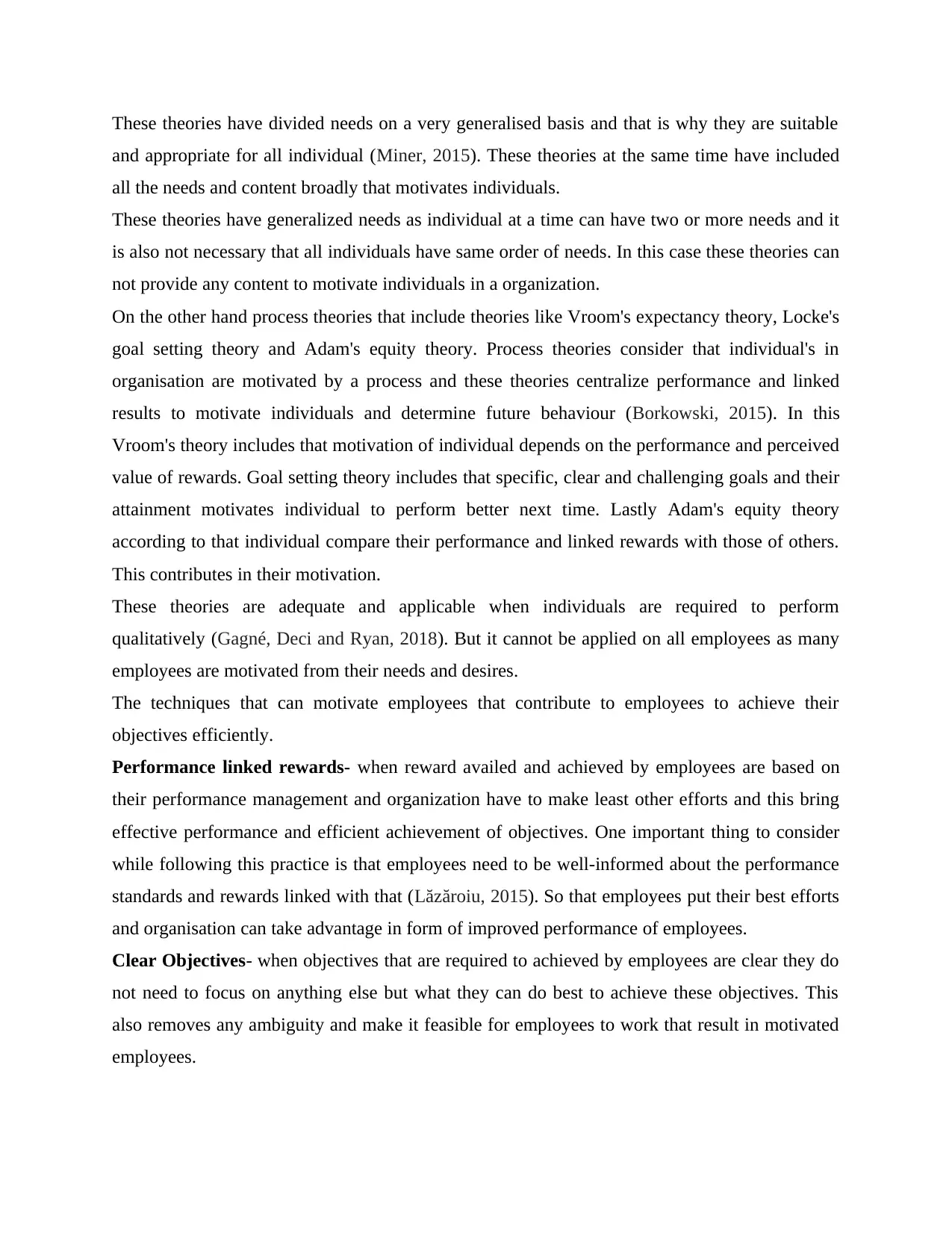
These theories have divided needs on a very generalised basis and that is why they are suitable
and appropriate for all individual (Miner, 2015). These theories at the same time have included
all the needs and content broadly that motivates individuals.
These theories have generalized needs as individual at a time can have two or more needs and it
is also not necessary that all individuals have same order of needs. In this case these theories can
not provide any content to motivate individuals in a organization.
On the other hand process theories that include theories like Vroom's expectancy theory, Locke's
goal setting theory and Adam's equity theory. Process theories consider that individual's in
organisation are motivated by a process and these theories centralize performance and linked
results to motivate individuals and determine future behaviour (Borkowski, 2015). In this
Vroom's theory includes that motivation of individual depends on the performance and perceived
value of rewards. Goal setting theory includes that specific, clear and challenging goals and their
attainment motivates individual to perform better next time. Lastly Adam's equity theory
according to that individual compare their performance and linked rewards with those of others.
This contributes in their motivation.
These theories are adequate and applicable when individuals are required to perform
qualitatively (Gagné, Deci and Ryan, 2018). But it cannot be applied on all employees as many
employees are motivated from their needs and desires.
The techniques that can motivate employees that contribute to employees to achieve their
objectives efficiently.
Performance linked rewards- when reward availed and achieved by employees are based on
their performance management and organization have to make least other efforts and this bring
effective performance and efficient achievement of objectives. One important thing to consider
while following this practice is that employees need to be well-informed about the performance
standards and rewards linked with that (Lăzăroiu, 2015). So that employees put their best efforts
and organisation can take advantage in form of improved performance of employees.
Clear Objectives- when objectives that are required to achieved by employees are clear they do
not need to focus on anything else but what they can do best to achieve these objectives. This
also removes any ambiguity and make it feasible for employees to work that result in motivated
employees.
and appropriate for all individual (Miner, 2015). These theories at the same time have included
all the needs and content broadly that motivates individuals.
These theories have generalized needs as individual at a time can have two or more needs and it
is also not necessary that all individuals have same order of needs. In this case these theories can
not provide any content to motivate individuals in a organization.
On the other hand process theories that include theories like Vroom's expectancy theory, Locke's
goal setting theory and Adam's equity theory. Process theories consider that individual's in
organisation are motivated by a process and these theories centralize performance and linked
results to motivate individuals and determine future behaviour (Borkowski, 2015). In this
Vroom's theory includes that motivation of individual depends on the performance and perceived
value of rewards. Goal setting theory includes that specific, clear and challenging goals and their
attainment motivates individual to perform better next time. Lastly Adam's equity theory
according to that individual compare their performance and linked rewards with those of others.
This contributes in their motivation.
These theories are adequate and applicable when individuals are required to perform
qualitatively (Gagné, Deci and Ryan, 2018). But it cannot be applied on all employees as many
employees are motivated from their needs and desires.
The techniques that can motivate employees that contribute to employees to achieve their
objectives efficiently.
Performance linked rewards- when reward availed and achieved by employees are based on
their performance management and organization have to make least other efforts and this bring
effective performance and efficient achievement of objectives. One important thing to consider
while following this practice is that employees need to be well-informed about the performance
standards and rewards linked with that (Lăzăroiu, 2015). So that employees put their best efforts
and organisation can take advantage in form of improved performance of employees.
Clear Objectives- when objectives that are required to achieved by employees are clear they do
not need to focus on anything else but what they can do best to achieve these objectives. This
also removes any ambiguity and make it feasible for employees to work that result in motivated
employees.
⊘ This is a preview!⊘
Do you want full access?
Subscribe today to unlock all pages.

Trusted by 1+ million students worldwide
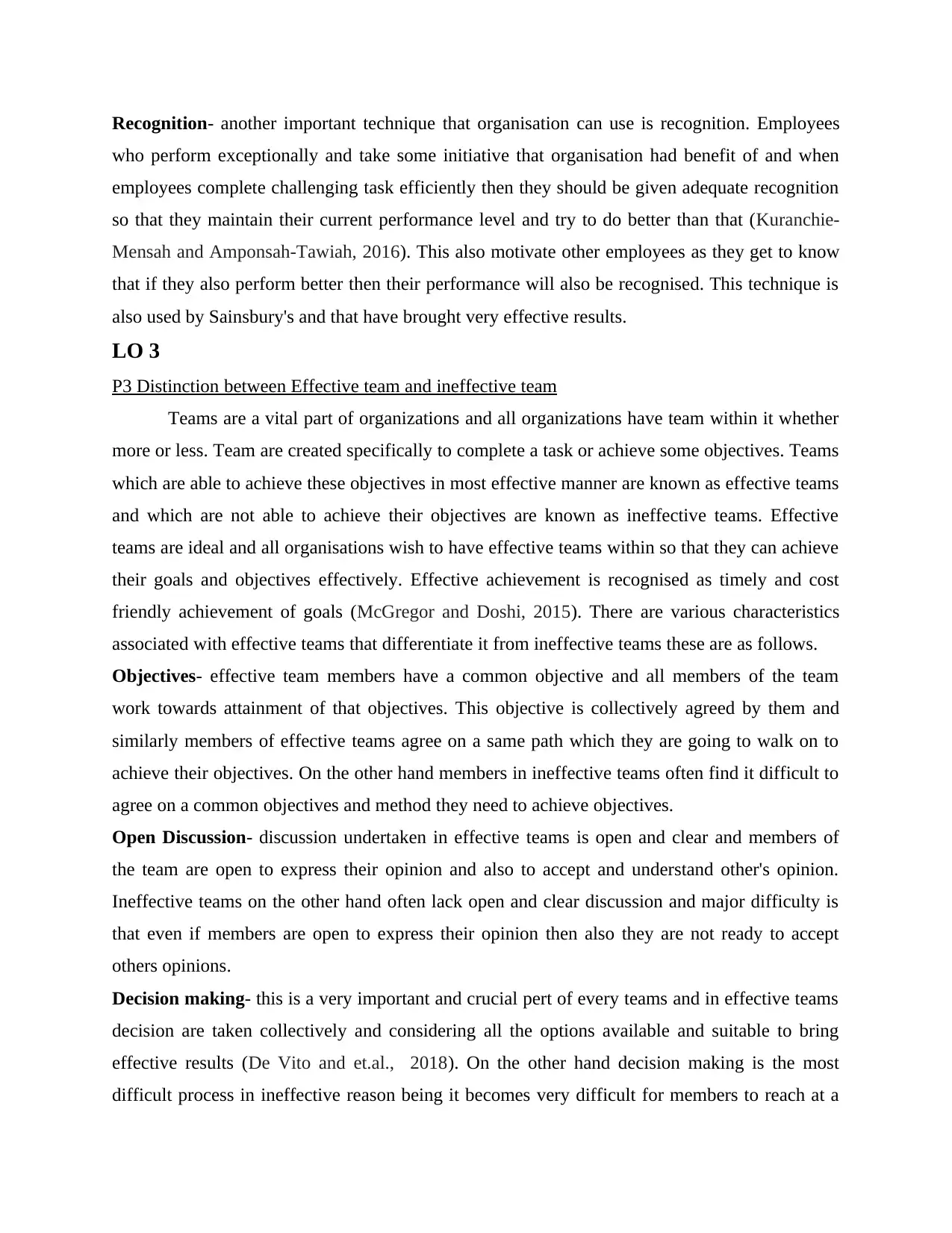
Recognition- another important technique that organisation can use is recognition. Employees
who perform exceptionally and take some initiative that organisation had benefit of and when
employees complete challenging task efficiently then they should be given adequate recognition
so that they maintain their current performance level and try to do better than that (Kuranchie-
Mensah and Amponsah-Tawiah, 2016). This also motivate other employees as they get to know
that if they also perform better then their performance will also be recognised. This technique is
also used by Sainsbury's and that have brought very effective results.
LO 3
P3 Distinction between Effective team and ineffective team
Teams are a vital part of organizations and all organizations have team within it whether
more or less. Team are created specifically to complete a task or achieve some objectives. Teams
which are able to achieve these objectives in most effective manner are known as effective teams
and which are not able to achieve their objectives are known as ineffective teams. Effective
teams are ideal and all organisations wish to have effective teams within so that they can achieve
their goals and objectives effectively. Effective achievement is recognised as timely and cost
friendly achievement of goals (McGregor and Doshi, 2015). There are various characteristics
associated with effective teams that differentiate it from ineffective teams these are as follows.
Objectives- effective team members have a common objective and all members of the team
work towards attainment of that objectives. This objective is collectively agreed by them and
similarly members of effective teams agree on a same path which they are going to walk on to
achieve their objectives. On the other hand members in ineffective teams often find it difficult to
agree on a common objectives and method they need to achieve objectives.
Open Discussion- discussion undertaken in effective teams is open and clear and members of
the team are open to express their opinion and also to accept and understand other's opinion.
Ineffective teams on the other hand often lack open and clear discussion and major difficulty is
that even if members are open to express their opinion then also they are not ready to accept
others opinions.
Decision making- this is a very important and crucial pert of every teams and in effective teams
decision are taken collectively and considering all the options available and suitable to bring
effective results (De Vito and et.al., 2018). On the other hand decision making is the most
difficult process in ineffective reason being it becomes very difficult for members to reach at a
who perform exceptionally and take some initiative that organisation had benefit of and when
employees complete challenging task efficiently then they should be given adequate recognition
so that they maintain their current performance level and try to do better than that (Kuranchie-
Mensah and Amponsah-Tawiah, 2016). This also motivate other employees as they get to know
that if they also perform better then their performance will also be recognised. This technique is
also used by Sainsbury's and that have brought very effective results.
LO 3
P3 Distinction between Effective team and ineffective team
Teams are a vital part of organizations and all organizations have team within it whether
more or less. Team are created specifically to complete a task or achieve some objectives. Teams
which are able to achieve these objectives in most effective manner are known as effective teams
and which are not able to achieve their objectives are known as ineffective teams. Effective
teams are ideal and all organisations wish to have effective teams within so that they can achieve
their goals and objectives effectively. Effective achievement is recognised as timely and cost
friendly achievement of goals (McGregor and Doshi, 2015). There are various characteristics
associated with effective teams that differentiate it from ineffective teams these are as follows.
Objectives- effective team members have a common objective and all members of the team
work towards attainment of that objectives. This objective is collectively agreed by them and
similarly members of effective teams agree on a same path which they are going to walk on to
achieve their objectives. On the other hand members in ineffective teams often find it difficult to
agree on a common objectives and method they need to achieve objectives.
Open Discussion- discussion undertaken in effective teams is open and clear and members of
the team are open to express their opinion and also to accept and understand other's opinion.
Ineffective teams on the other hand often lack open and clear discussion and major difficulty is
that even if members are open to express their opinion then also they are not ready to accept
others opinions.
Decision making- this is a very important and crucial pert of every teams and in effective teams
decision are taken collectively and considering all the options available and suitable to bring
effective results (De Vito and et.al., 2018). On the other hand decision making is the most
difficult process in ineffective reason being it becomes very difficult for members to reach at a
Paraphrase This Document
Need a fresh take? Get an instant paraphrase of this document with our AI Paraphraser
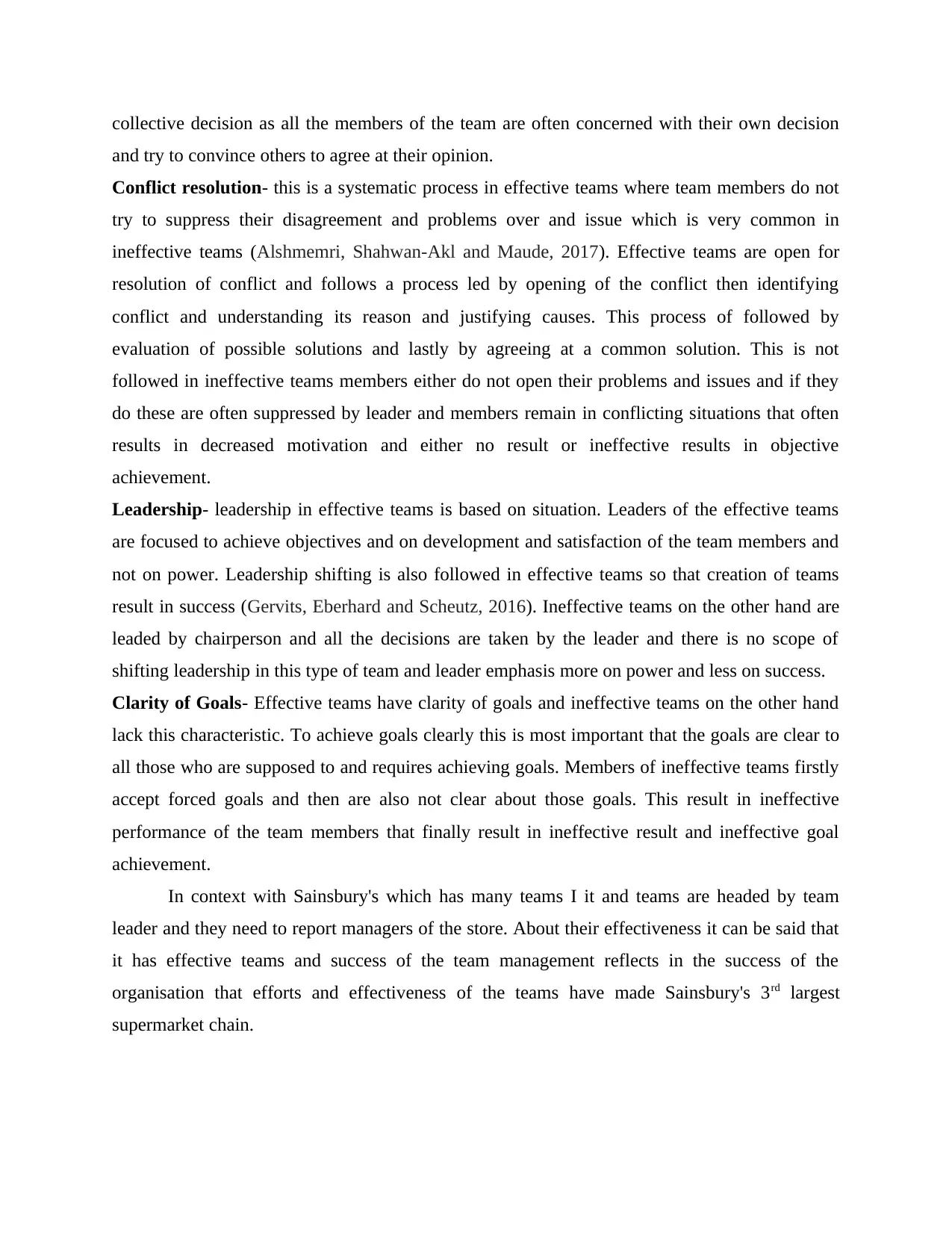
collective decision as all the members of the team are often concerned with their own decision
and try to convince others to agree at their opinion.
Conflict resolution- this is a systematic process in effective teams where team members do not
try to suppress their disagreement and problems over and issue which is very common in
ineffective teams (Alshmemri, Shahwan-Akl and Maude, 2017). Effective teams are open for
resolution of conflict and follows a process led by opening of the conflict then identifying
conflict and understanding its reason and justifying causes. This process of followed by
evaluation of possible solutions and lastly by agreeing at a common solution. This is not
followed in ineffective teams members either do not open their problems and issues and if they
do these are often suppressed by leader and members remain in conflicting situations that often
results in decreased motivation and either no result or ineffective results in objective
achievement.
Leadership- leadership in effective teams is based on situation. Leaders of the effective teams
are focused to achieve objectives and on development and satisfaction of the team members and
not on power. Leadership shifting is also followed in effective teams so that creation of teams
result in success (Gervits, Eberhard and Scheutz, 2016). Ineffective teams on the other hand are
leaded by chairperson and all the decisions are taken by the leader and there is no scope of
shifting leadership in this type of team and leader emphasis more on power and less on success.
Clarity of Goals- Effective teams have clarity of goals and ineffective teams on the other hand
lack this characteristic. To achieve goals clearly this is most important that the goals are clear to
all those who are supposed to and requires achieving goals. Members of ineffective teams firstly
accept forced goals and then are also not clear about those goals. This result in ineffective
performance of the team members that finally result in ineffective result and ineffective goal
achievement.
In context with Sainsbury's which has many teams I it and teams are headed by team
leader and they need to report managers of the store. About their effectiveness it can be said that
it has effective teams and success of the team management reflects in the success of the
organisation that efforts and effectiveness of the teams have made Sainsbury's 3rd largest
supermarket chain.
and try to convince others to agree at their opinion.
Conflict resolution- this is a systematic process in effective teams where team members do not
try to suppress their disagreement and problems over and issue which is very common in
ineffective teams (Alshmemri, Shahwan-Akl and Maude, 2017). Effective teams are open for
resolution of conflict and follows a process led by opening of the conflict then identifying
conflict and understanding its reason and justifying causes. This process of followed by
evaluation of possible solutions and lastly by agreeing at a common solution. This is not
followed in ineffective teams members either do not open their problems and issues and if they
do these are often suppressed by leader and members remain in conflicting situations that often
results in decreased motivation and either no result or ineffective results in objective
achievement.
Leadership- leadership in effective teams is based on situation. Leaders of the effective teams
are focused to achieve objectives and on development and satisfaction of the team members and
not on power. Leadership shifting is also followed in effective teams so that creation of teams
result in success (Gervits, Eberhard and Scheutz, 2016). Ineffective teams on the other hand are
leaded by chairperson and all the decisions are taken by the leader and there is no scope of
shifting leadership in this type of team and leader emphasis more on power and less on success.
Clarity of Goals- Effective teams have clarity of goals and ineffective teams on the other hand
lack this characteristic. To achieve goals clearly this is most important that the goals are clear to
all those who are supposed to and requires achieving goals. Members of ineffective teams firstly
accept forced goals and then are also not clear about those goals. This result in ineffective
performance of the team members that finally result in ineffective result and ineffective goal
achievement.
In context with Sainsbury's which has many teams I it and teams are headed by team
leader and they need to report managers of the store. About their effectiveness it can be said that
it has effective teams and success of the team management reflects in the success of the
organisation that efforts and effectiveness of the teams have made Sainsbury's 3rd largest
supermarket chain.
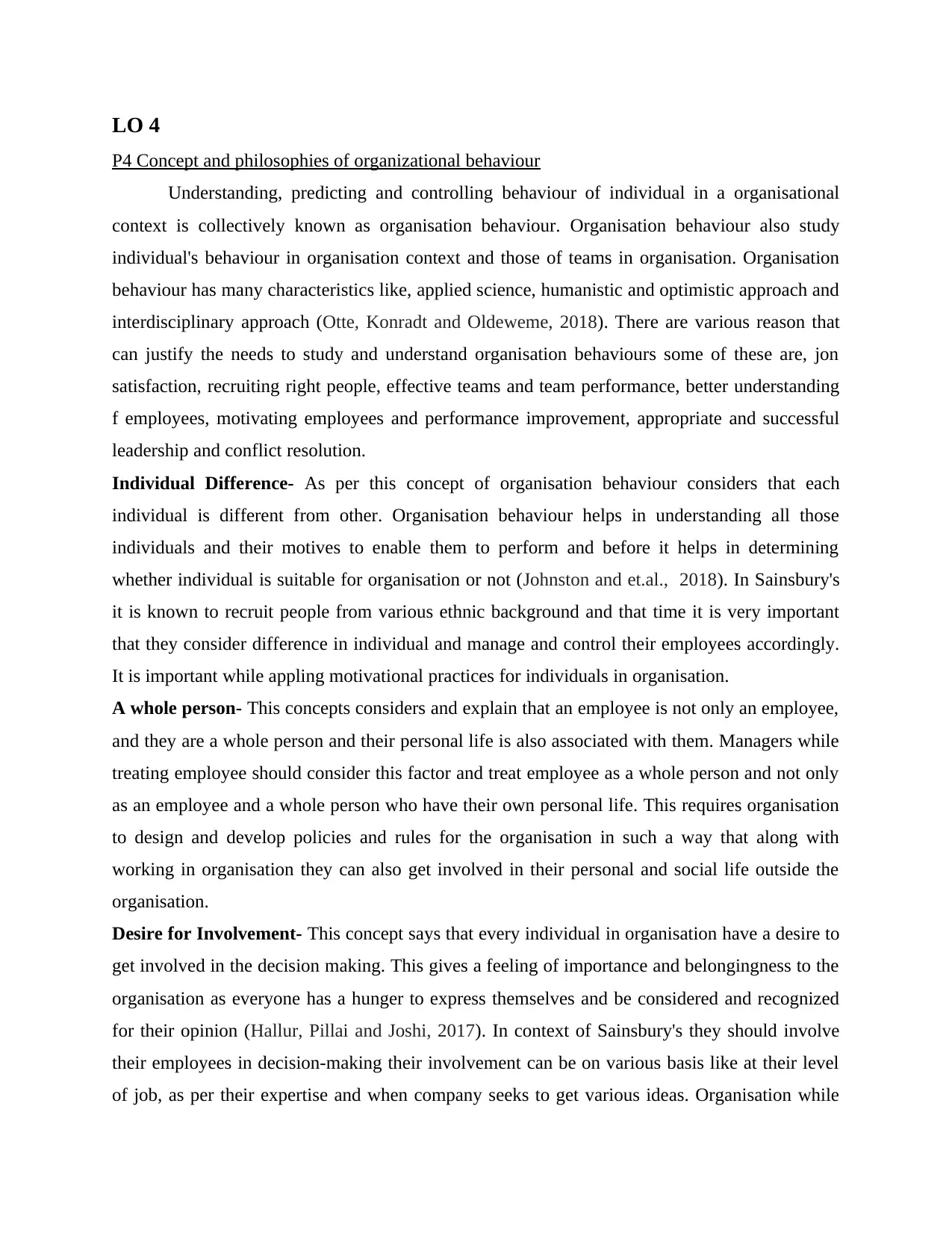
LO 4
P4 Concept and philosophies of organizational behaviour
Understanding, predicting and controlling behaviour of individual in a organisational
context is collectively known as organisation behaviour. Organisation behaviour also study
individual's behaviour in organisation context and those of teams in organisation. Organisation
behaviour has many characteristics like, applied science, humanistic and optimistic approach and
interdisciplinary approach (Otte, Konradt and Oldeweme, 2018). There are various reason that
can justify the needs to study and understand organisation behaviours some of these are, jon
satisfaction, recruiting right people, effective teams and team performance, better understanding
f employees, motivating employees and performance improvement, appropriate and successful
leadership and conflict resolution.
Individual Difference- As per this concept of organisation behaviour considers that each
individual is different from other. Organisation behaviour helps in understanding all those
individuals and their motives to enable them to perform and before it helps in determining
whether individual is suitable for organisation or not (Johnston and et.al., 2018). In Sainsbury's
it is known to recruit people from various ethnic background and that time it is very important
that they consider difference in individual and manage and control their employees accordingly.
It is important while appling motivational practices for individuals in organisation.
A whole person- This concepts considers and explain that an employee is not only an employee,
and they are a whole person and their personal life is also associated with them. Managers while
treating employee should consider this factor and treat employee as a whole person and not only
as an employee and a whole person who have their own personal life. This requires organisation
to design and develop policies and rules for the organisation in such a way that along with
working in organisation they can also get involved in their personal and social life outside the
organisation.
Desire for Involvement- This concept says that every individual in organisation have a desire to
get involved in the decision making. This gives a feeling of importance and belongingness to the
organisation as everyone has a hunger to express themselves and be considered and recognized
for their opinion (Hallur, Pillai and Joshi, 2017). In context of Sainsbury's they should involve
their employees in decision-making their involvement can be on various basis like at their level
of job, as per their expertise and when company seeks to get various ideas. Organisation while
P4 Concept and philosophies of organizational behaviour
Understanding, predicting and controlling behaviour of individual in a organisational
context is collectively known as organisation behaviour. Organisation behaviour also study
individual's behaviour in organisation context and those of teams in organisation. Organisation
behaviour has many characteristics like, applied science, humanistic and optimistic approach and
interdisciplinary approach (Otte, Konradt and Oldeweme, 2018). There are various reason that
can justify the needs to study and understand organisation behaviours some of these are, jon
satisfaction, recruiting right people, effective teams and team performance, better understanding
f employees, motivating employees and performance improvement, appropriate and successful
leadership and conflict resolution.
Individual Difference- As per this concept of organisation behaviour considers that each
individual is different from other. Organisation behaviour helps in understanding all those
individuals and their motives to enable them to perform and before it helps in determining
whether individual is suitable for organisation or not (Johnston and et.al., 2018). In Sainsbury's
it is known to recruit people from various ethnic background and that time it is very important
that they consider difference in individual and manage and control their employees accordingly.
It is important while appling motivational practices for individuals in organisation.
A whole person- This concepts considers and explain that an employee is not only an employee,
and they are a whole person and their personal life is also associated with them. Managers while
treating employee should consider this factor and treat employee as a whole person and not only
as an employee and a whole person who have their own personal life. This requires organisation
to design and develop policies and rules for the organisation in such a way that along with
working in organisation they can also get involved in their personal and social life outside the
organisation.
Desire for Involvement- This concept says that every individual in organisation have a desire to
get involved in the decision making. This gives a feeling of importance and belongingness to the
organisation as everyone has a hunger to express themselves and be considered and recognized
for their opinion (Hallur, Pillai and Joshi, 2017). In context of Sainsbury's they should involve
their employees in decision-making their involvement can be on various basis like at their level
of job, as per their expertise and when company seeks to get various ideas. Organisation while
⊘ This is a preview!⊘
Do you want full access?
Subscribe today to unlock all pages.

Trusted by 1+ million students worldwide
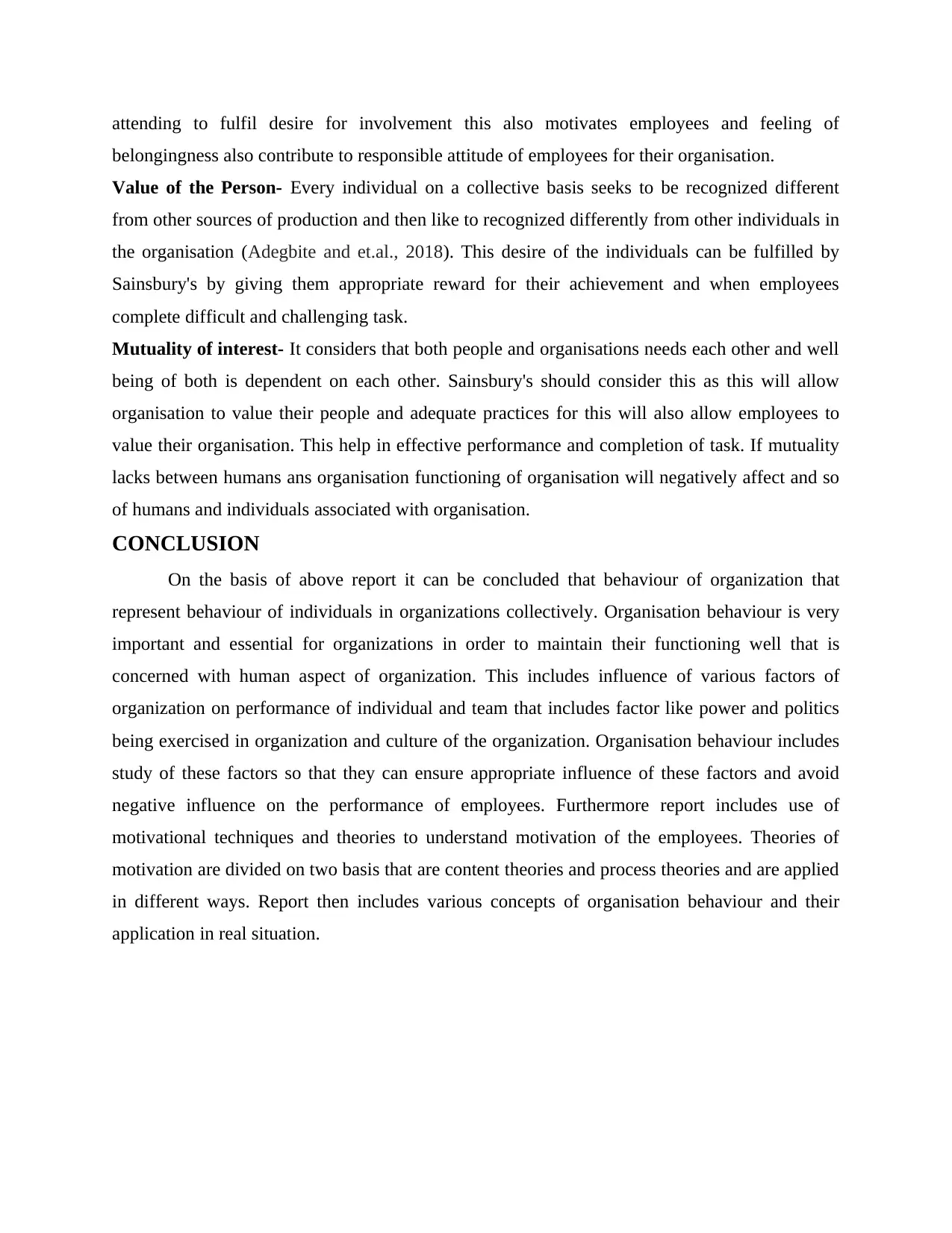
attending to fulfil desire for involvement this also motivates employees and feeling of
belongingness also contribute to responsible attitude of employees for their organisation.
Value of the Person- Every individual on a collective basis seeks to be recognized different
from other sources of production and then like to recognized differently from other individuals in
the organisation (Adegbite and et.al., 2018). This desire of the individuals can be fulfilled by
Sainsbury's by giving them appropriate reward for their achievement and when employees
complete difficult and challenging task.
Mutuality of interest- It considers that both people and organisations needs each other and well
being of both is dependent on each other. Sainsbury's should consider this as this will allow
organisation to value their people and adequate practices for this will also allow employees to
value their organisation. This help in effective performance and completion of task. If mutuality
lacks between humans ans organisation functioning of organisation will negatively affect and so
of humans and individuals associated with organisation.
CONCLUSION
On the basis of above report it can be concluded that behaviour of organization that
represent behaviour of individuals in organizations collectively. Organisation behaviour is very
important and essential for organizations in order to maintain their functioning well that is
concerned with human aspect of organization. This includes influence of various factors of
organization on performance of individual and team that includes factor like power and politics
being exercised in organization and culture of the organization. Organisation behaviour includes
study of these factors so that they can ensure appropriate influence of these factors and avoid
negative influence on the performance of employees. Furthermore report includes use of
motivational techniques and theories to understand motivation of the employees. Theories of
motivation are divided on two basis that are content theories and process theories and are applied
in different ways. Report then includes various concepts of organisation behaviour and their
application in real situation.
belongingness also contribute to responsible attitude of employees for their organisation.
Value of the Person- Every individual on a collective basis seeks to be recognized different
from other sources of production and then like to recognized differently from other individuals in
the organisation (Adegbite and et.al., 2018). This desire of the individuals can be fulfilled by
Sainsbury's by giving them appropriate reward for their achievement and when employees
complete difficult and challenging task.
Mutuality of interest- It considers that both people and organisations needs each other and well
being of both is dependent on each other. Sainsbury's should consider this as this will allow
organisation to value their people and adequate practices for this will also allow employees to
value their organisation. This help in effective performance and completion of task. If mutuality
lacks between humans ans organisation functioning of organisation will negatively affect and so
of humans and individuals associated with organisation.
CONCLUSION
On the basis of above report it can be concluded that behaviour of organization that
represent behaviour of individuals in organizations collectively. Organisation behaviour is very
important and essential for organizations in order to maintain their functioning well that is
concerned with human aspect of organization. This includes influence of various factors of
organization on performance of individual and team that includes factor like power and politics
being exercised in organization and culture of the organization. Organisation behaviour includes
study of these factors so that they can ensure appropriate influence of these factors and avoid
negative influence on the performance of employees. Furthermore report includes use of
motivational techniques and theories to understand motivation of the employees. Theories of
motivation are divided on two basis that are content theories and process theories and are applied
in different ways. Report then includes various concepts of organisation behaviour and their
application in real situation.
Paraphrase This Document
Need a fresh take? Get an instant paraphrase of this document with our AI Paraphraser
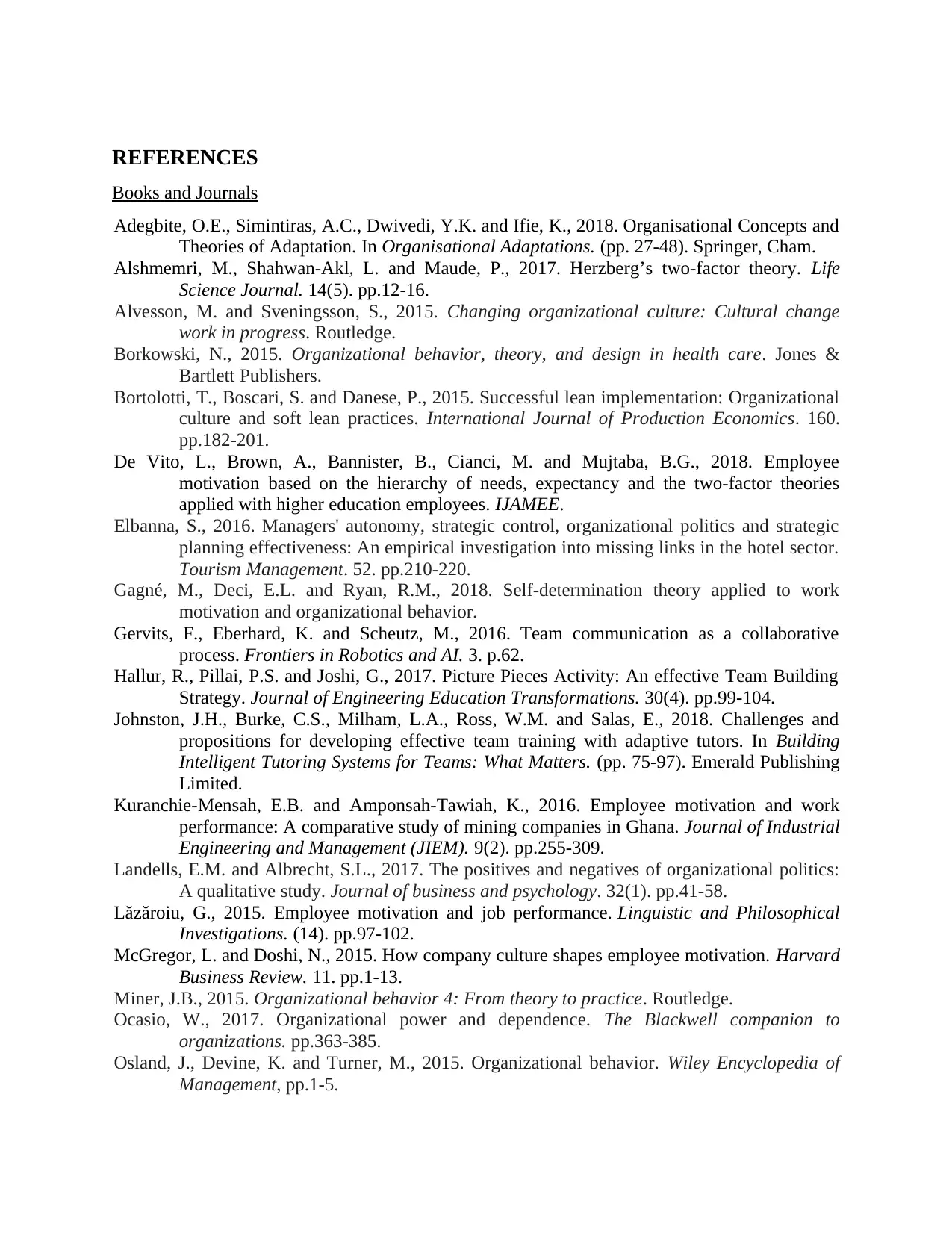
REFERENCES
Books and Journals
Adegbite, O.E., Simintiras, A.C., Dwivedi, Y.K. and Ifie, K., 2018. Organisational Concepts and
Theories of Adaptation. In Organisational Adaptations. (pp. 27-48). Springer, Cham.
Alshmemri, M., Shahwan-Akl, L. and Maude, P., 2017. Herzberg’s two-factor theory. Life
Science Journal. 14(5). pp.12-16.
Alvesson, M. and Sveningsson, S., 2015. Changing organizational culture: Cultural change
work in progress. Routledge.
Borkowski, N., 2015. Organizational behavior, theory, and design in health care. Jones &
Bartlett Publishers.
Bortolotti, T., Boscari, S. and Danese, P., 2015. Successful lean implementation: Organizational
culture and soft lean practices. International Journal of Production Economics. 160.
pp.182-201.
De Vito, L., Brown, A., Bannister, B., Cianci, M. and Mujtaba, B.G., 2018. Employee
motivation based on the hierarchy of needs, expectancy and the two-factor theories
applied with higher education employees. IJAMEE.
Elbanna, S., 2016. Managers' autonomy, strategic control, organizational politics and strategic
planning effectiveness: An empirical investigation into missing links in the hotel sector.
Tourism Management. 52. pp.210-220.
Gagné, M., Deci, E.L. and Ryan, R.M., 2018. Self-determination theory applied to work
motivation and organizational behavior.
Gervits, F., Eberhard, K. and Scheutz, M., 2016. Team communication as a collaborative
process. Frontiers in Robotics and AI. 3. p.62.
Hallur, R., Pillai, P.S. and Joshi, G., 2017. Picture Pieces Activity: An effective Team Building
Strategy. Journal of Engineering Education Transformations. 30(4). pp.99-104.
Johnston, J.H., Burke, C.S., Milham, L.A., Ross, W.M. and Salas, E., 2018. Challenges and
propositions for developing effective team training with adaptive tutors. In Building
Intelligent Tutoring Systems for Teams: What Matters. (pp. 75-97). Emerald Publishing
Limited.
Kuranchie-Mensah, E.B. and Amponsah-Tawiah, K., 2016. Employee motivation and work
performance: A comparative study of mining companies in Ghana. Journal of Industrial
Engineering and Management (JIEM). 9(2). pp.255-309.
Landells, E.M. and Albrecht, S.L., 2017. The positives and negatives of organizational politics:
A qualitative study. Journal of business and psychology. 32(1). pp.41-58.
Lăzăroiu, G., 2015. Employee motivation and job performance. Linguistic and Philosophical
Investigations. (14). pp.97-102.
McGregor, L. and Doshi, N., 2015. How company culture shapes employee motivation. Harvard
Business Review. 11. pp.1-13.
Miner, J.B., 2015. Organizational behavior 4: From theory to practice. Routledge.
Ocasio, W., 2017. Organizational power and dependence. The Blackwell companion to
organizations. pp.363-385.
Osland, J., Devine, K. and Turner, M., 2015. Organizational behavior. Wiley Encyclopedia of
Management, pp.1-5.
Books and Journals
Adegbite, O.E., Simintiras, A.C., Dwivedi, Y.K. and Ifie, K., 2018. Organisational Concepts and
Theories of Adaptation. In Organisational Adaptations. (pp. 27-48). Springer, Cham.
Alshmemri, M., Shahwan-Akl, L. and Maude, P., 2017. Herzberg’s two-factor theory. Life
Science Journal. 14(5). pp.12-16.
Alvesson, M. and Sveningsson, S., 2015. Changing organizational culture: Cultural change
work in progress. Routledge.
Borkowski, N., 2015. Organizational behavior, theory, and design in health care. Jones &
Bartlett Publishers.
Bortolotti, T., Boscari, S. and Danese, P., 2015. Successful lean implementation: Organizational
culture and soft lean practices. International Journal of Production Economics. 160.
pp.182-201.
De Vito, L., Brown, A., Bannister, B., Cianci, M. and Mujtaba, B.G., 2018. Employee
motivation based on the hierarchy of needs, expectancy and the two-factor theories
applied with higher education employees. IJAMEE.
Elbanna, S., 2016. Managers' autonomy, strategic control, organizational politics and strategic
planning effectiveness: An empirical investigation into missing links in the hotel sector.
Tourism Management. 52. pp.210-220.
Gagné, M., Deci, E.L. and Ryan, R.M., 2018. Self-determination theory applied to work
motivation and organizational behavior.
Gervits, F., Eberhard, K. and Scheutz, M., 2016. Team communication as a collaborative
process. Frontiers in Robotics and AI. 3. p.62.
Hallur, R., Pillai, P.S. and Joshi, G., 2017. Picture Pieces Activity: An effective Team Building
Strategy. Journal of Engineering Education Transformations. 30(4). pp.99-104.
Johnston, J.H., Burke, C.S., Milham, L.A., Ross, W.M. and Salas, E., 2018. Challenges and
propositions for developing effective team training with adaptive tutors. In Building
Intelligent Tutoring Systems for Teams: What Matters. (pp. 75-97). Emerald Publishing
Limited.
Kuranchie-Mensah, E.B. and Amponsah-Tawiah, K., 2016. Employee motivation and work
performance: A comparative study of mining companies in Ghana. Journal of Industrial
Engineering and Management (JIEM). 9(2). pp.255-309.
Landells, E.M. and Albrecht, S.L., 2017. The positives and negatives of organizational politics:
A qualitative study. Journal of business and psychology. 32(1). pp.41-58.
Lăzăroiu, G., 2015. Employee motivation and job performance. Linguistic and Philosophical
Investigations. (14). pp.97-102.
McGregor, L. and Doshi, N., 2015. How company culture shapes employee motivation. Harvard
Business Review. 11. pp.1-13.
Miner, J.B., 2015. Organizational behavior 4: From theory to practice. Routledge.
Ocasio, W., 2017. Organizational power and dependence. The Blackwell companion to
organizations. pp.363-385.
Osland, J., Devine, K. and Turner, M., 2015. Organizational behavior. Wiley Encyclopedia of
Management, pp.1-5.
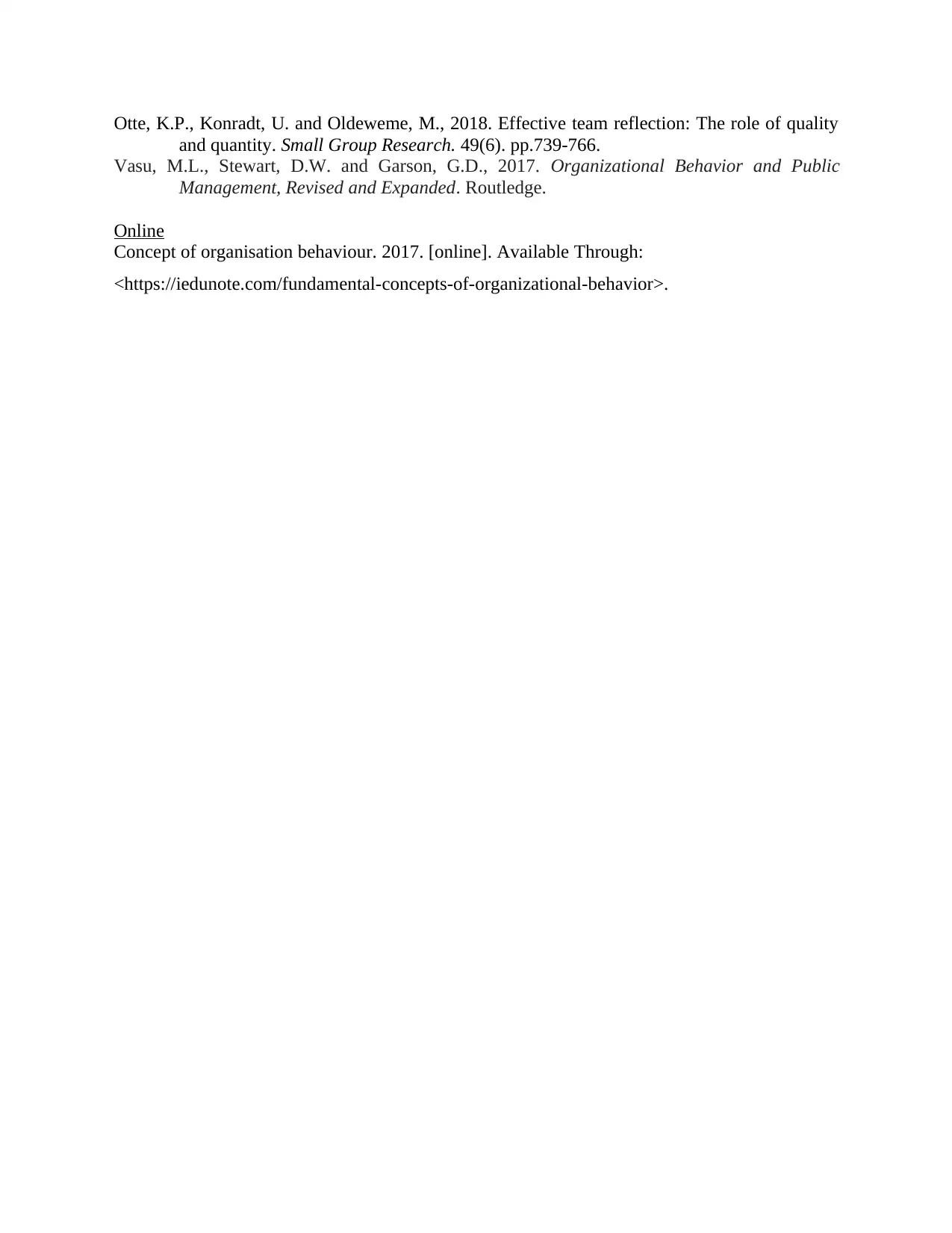
Otte, K.P., Konradt, U. and Oldeweme, M., 2018. Effective team reflection: The role of quality
and quantity. Small Group Research. 49(6). pp.739-766.
Vasu, M.L., Stewart, D.W. and Garson, G.D., 2017. Organizational Behavior and Public
Management, Revised and Expanded. Routledge.
Online
Concept of organisation behaviour. 2017. [online]. Available Through:
<https://iedunote.com/fundamental-concepts-of-organizational-behavior>.
and quantity. Small Group Research. 49(6). pp.739-766.
Vasu, M.L., Stewart, D.W. and Garson, G.D., 2017. Organizational Behavior and Public
Management, Revised and Expanded. Routledge.
Online
Concept of organisation behaviour. 2017. [online]. Available Through:
<https://iedunote.com/fundamental-concepts-of-organizational-behavior>.
⊘ This is a preview!⊘
Do you want full access?
Subscribe today to unlock all pages.

Trusted by 1+ million students worldwide
1 out of 12
Related Documents
Your All-in-One AI-Powered Toolkit for Academic Success.
+13062052269
info@desklib.com
Available 24*7 on WhatsApp / Email
![[object Object]](/_next/static/media/star-bottom.7253800d.svg)
Unlock your academic potential
Copyright © 2020–2025 A2Z Services. All Rights Reserved. Developed and managed by ZUCOL.





